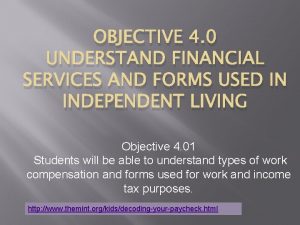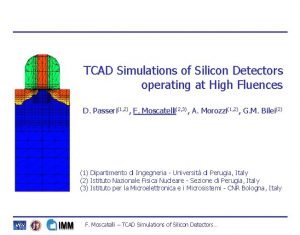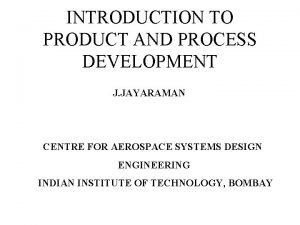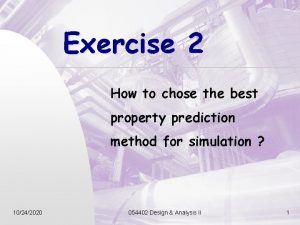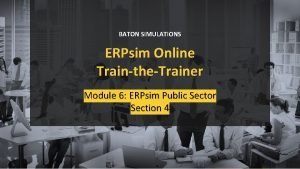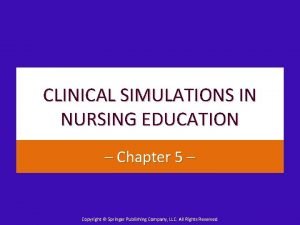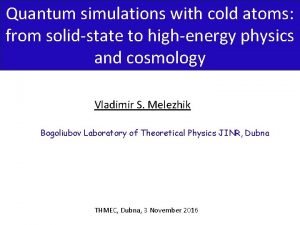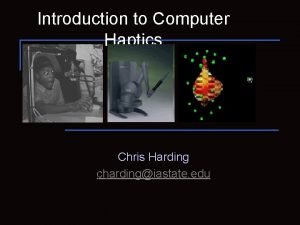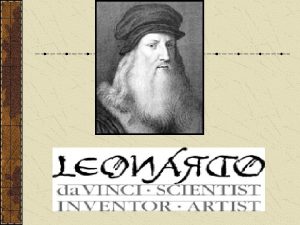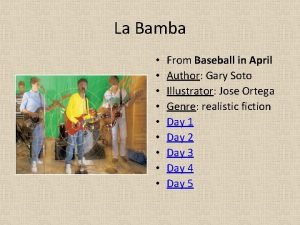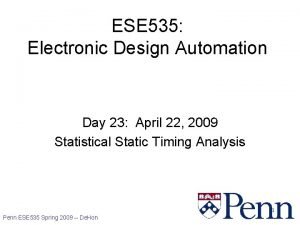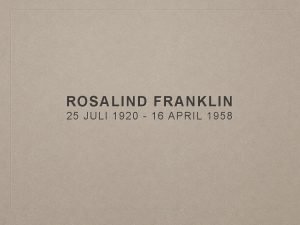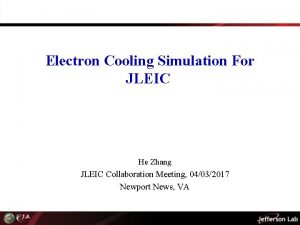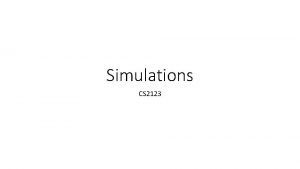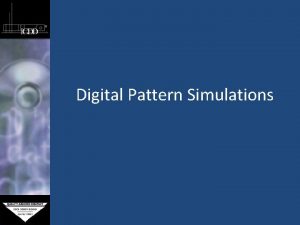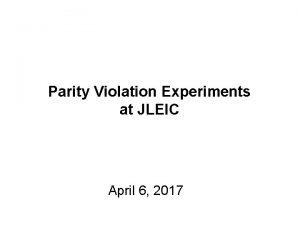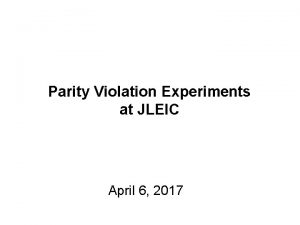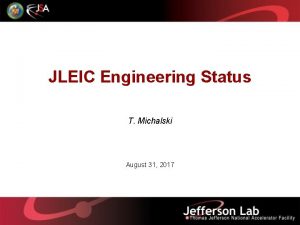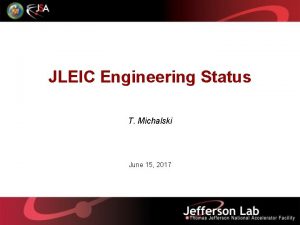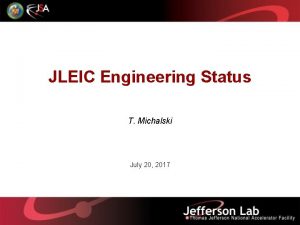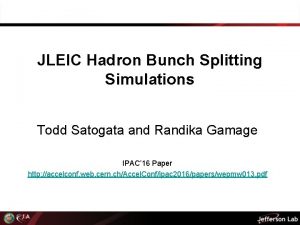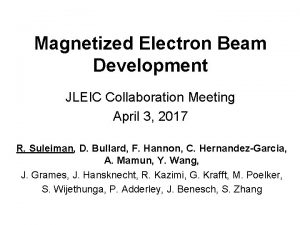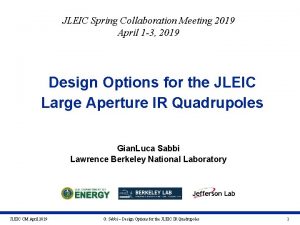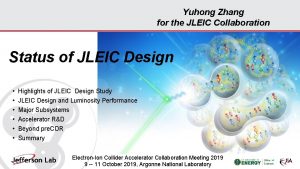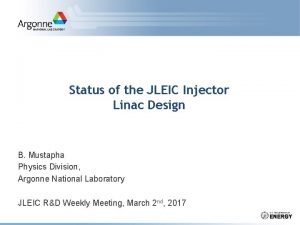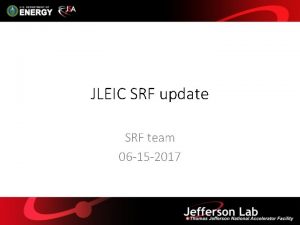JLEIC simulations status April 3 rd 2017 Y








![0 -5 DISP_X&Y[m] BETA_X&Y[m] 5 40 Booster Lattice (8 Ge. V, gt = 16. 0 -5 DISP_X&Y[m] BETA_X&Y[m] 5 40 Booster Lattice (8 Ge. V, gt = 16.](https://slidetodoc.com/presentation_image_h2/fe3696fe30c4f879dffa575dc77bdcfc/image-9.jpg)






- Slides: 15

JLEIC simulations status April 3 rd, 2017 Y. Roblin

Scope of Simulations • Intermediate goal is to arrive at what is needed for a good pre-CDR and subsequently CDR • • • Ion Linac (See talk by Sang-hoon Kim) Ion Collider Ring Booster Integration with Ion Linac injection Electron Ring Bunched beam Cooler

Simulation Tasks for Ion Collider Ring Basic simulation of single-particle dynamic aperture and momentum acceptance (completed by G. Wei) DONE Spin tracking (A. M. Kondratenko et al. , talk by V. S. Morozov) DONE Beam injection, acceleration, and formation (talk by T. Satogata) Electron cooling simulations (talk by S. Benson) Crab crossing design and simulations (talk by J. Delayen) Beam-beam simulations (talk by B. Terzic) Collective effects and instabilities (talk by R. Li) Detector solenoid integration study (completed by G. Wei) DONE Error and multipole tolerances – Strength and alignment error study (completed by G. Wei) DONE – FFQ multipole study (completed by G. Wei) DONE – Local compensation of magnet multipoles – Complete simulation with multipoles, misalignments and detector solenoid – Acceleration with field-dependent multipoles Dynamics optimization including beam-beam and crab crossing Beta-squeeze simulation

Strength and Alignment Error Study. G. Wei With error & correction 10 seeds 90 σ 60 σ 100 Ge. V proton ex/ey(nor. mm-mrad) DA origin DA with error Case 1, strong cooling 0. 35/0. 07 ~ 90 σ ~ 60 σ ~ 48 σ ~ 32 σ Case 2, large emittance 1. 2/1. 2

FFQ Multipole Sensitivity Study G. Wei DA: 10 σ for 60 Ge. V proton & 12 σ for 100 Ge. V proton DA • Larger beam emittance with week cooling results in the tighter limit multipole • Survey with 0. 9/0. 9 mm-mrad of emittance gives a balance between multipole field of IR triplet and dynamic aperture.

G. Wei Detector Solenoid Compensation Scheme Ø • • A scheme: : Skew Quadrupole Two dipole correctors on each side of the IP are used to make closed orbit correction. Anti-solenoid & skew quads to make decoupling. 4 skew quads with 0. 1 meter are enough for each side

Dynamic Aperture G. Wei • Red line: bare lattice • Black line: with detector solenoid • Dynamic aperture shrinks to 50 , but is large enough considering the final required dynamic aperture of 10

Booster tasks • Imaginary gamma-t lattice with super-ferric magnets (A. Bogacz) • Preliminary studies for space-charge and injection schemes (E. Nissen) • Halo Formation studies in the presence of resonance crossing • Optimization of working point, tunes and DA. • Lean on resources. Hoping to get a postdoc.
![0 5 DISPXYm BETAXYm 5 40 Booster Lattice 8 Ge V gt 16 0 -5 DISP_X&Y[m] BETA_X&Y[m] 5 40 Booster Lattice (8 Ge. V, gt = 16.](https://slidetodoc.com/presentation_image_h2/fe3696fe30c4f879dffa575dc77bdcfc/image-9.jpg)
0 -5 DISP_X&Y[m] BETA_X&Y[m] 5 40 Booster Lattice (8 Ge. V, gt = 16. 8 i ) 0 BETA_X BETA_Y DISP_X DISP_Y 275. 087 Proton beam energy (total) Ge. V 1. 2 - 8 m 275 deg 79. 8 Arc length m 103 / 85 Straight section length m 43 Maximum hor. / ver. functions m 22 / 22 Maximum hor. dispersion m 4. 3 Arc Bends: Circumference Lb = 120 cm B = 3. 13 Tesla bend ang. = 8. 12 deg. Sagitta = 2. 1 cm Straights’ crossing angle Arc Quadrupoles: Straight Quads: Lq = 40 cm GF = 12. 6 Tesla/m GD = -24. 5 Tesla/m Lq = 40 cm G = 12 -65 Tesla/m Lattice configured with super-ferric magnets Hor. / ver. betatron tunes x, y 7. 87 / 5. 85 Hor. / ver. natural chromaticities x, y -6. 8 / -4. 6 Momentum compaction factor -3. 6 10 -3 Hor. / ver. normalized emittance x, y Maximum hor. / ver. rms beam size at inj. x, y Alex Bogacz 9 µm rad 1/1 mm 5. 1 / 5. 1 JLEIC Collaboration Meeting, April 3 -5, 2017

Extreme Space-Charge Consideration • Incoherent space-charge tune shift at the injection plateau, where the beam is stored for a long time (105 or more turns). Qx/y = 7. 87 / 5. 85 DQsc= 0. 1 6 – Present baseline: DQsc = 0. 1 – More aggressive scenario: DQsc ≥ 0. 3 Qy Significant fraction of particles in the beam will move across the third-integer and quarter-integer resonance lines → increases the transverse amplitude of particles, leading to halo formation and eventually beam loss. Alex Bogacz 5. 5 Resonance crossing and halo formation 7. 5 2 3 4 5 Qx JLEIC Collaboration Meeting, April 3 -5, 2017 8

Next Step: Extreme Space-Charge Optimization Mitigation of halo formation and beam loss through comprehensive tracking studies (e. g. SYNERGIA) of resonance crossing in the presence of space-charge and implementation of modern resonance compensation techniques. Implementation of third-integer resonance crossing correction measures by creating anti-resonances via properly placed pairs of sextupoles. They would correct the stop-band width of these resonances to minimize the amplitude growth and hence beam loss. Establish the optimum injection energy, working point tunes, maximum current through assessment of the acceptable halo and beam loss. Alex Bogacz JLEIC Collaboration Meeting, April 3 -5, 2017

Simulation Tasks for Electron Ring Optimization towards small emittance DONE Chromatic Compensation, DA optimization (talk by Y. Nosochkov) 80% DONE Field errors, misalignments, multipoles (G. Wei) Injection Schemes from CEBAF (Lin, Guo) DONE Injection Optics (Lin, Roblin) Beam Feedback systems Beam Abort Systems not pre CDR? Beam effects, Gear Changing Effects (Roblin, Terzic et al ) in progress Impedance budget estimates, collective effects (talk by R. Li) in progress Electron polarization Tracking (F. Lin) 60 % DONE Polarization related design optimizations (Kondratenko et al)

JLEIC Electron Ring Plan Topics JLEIC Electron Ring Plan Start End Weeks Finished Personal Ring optimization towards small emittance 02/01/16 08/01/17 80% Lin Non-linear dynamics: chromaticity compensation, dynamic aperture, etc. 02/01/16 05/01/17 80% Lin, Nosochkov Field errors, misalignment, multipoles, etc. 05/01/17 07/01/17 Wei, et al. Path length correction scheme 100% Morozov, et al. Injection schemes from CEBAF 100% Guo, Lin Injection optics realization 05/01/17 07/01/17 Lin, Roblin Beam feedback and abort systems H. Wang, Guo, et al. Beam-beam and gear changing effects 03/01/17 Impedance budget estimate, single and multiple bunch instabilities 03/01/17 12/01/17 Roblin, et al. Li, et al. Electron polarization design Electron polarization tracking 01/01/16 08/01/17 Polarization-related design optimization 07/16/17 07/15/18 100% Lin 60% Lin Kondratenko, et al.

Bunched Beam Cooler tasks Topics Longitudinal match JLEIC Electron Ring Plan Start End Weeks Finished Personal 90% C. Tenant High charge e- injector 80% F. Hannon Design the merger 10 % F. Hannon Cooling section simulations 60% H. Zhang CCR transport 80% D. Douglas ERL linac 60 % D. Douglas CSR and other collective effects 40 % C. Tenant, R. Li S 2 E simulations 20 % C. Tenant

Outstanding tasks • Booster – Space charge effects, injection scheme – Ramping, bunch formation. • Collider rings – Electron cloud estimates, other collective effects. – Spin Tracking in electron ring – Injection into e- ring – Beam effects, Gear Changing simulations – Bunched beam cooling optimization
 Payroll card
Payroll card Tcad simulations
Tcad simulations Ippd key tenets
Ippd key tenets Don't gamble with physical properties for simulations
Don't gamble with physical properties for simulations World history simulations
World history simulations Baton simulations
Baton simulations Clinical simulations in nursing education
Clinical simulations in nursing education Simulations for solid state physics
Simulations for solid state physics Chris harding simulations
Chris harding simulations Leonardo da vinci was born on april 15 1452
Leonardo da vinci was born on april 15 1452 Easter happens around the same time as passover
Easter happens around the same time as passover La bamba gary soto
La bamba gary soto April 26 1564
April 26 1564 Earth day paragraphs
Earth day paragraphs 535 days before 23 april
535 days before 23 april April 1958
April 1958
